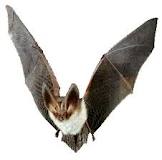
Excluding Bats - Helpful Tips
How to Get Rid of Bats

There are forty different species of bats found in the USA. The big brown rat, little brown bat, and
Mexican free-tailed bat are common bats in the United States. Bats rarely attack people and can be
beneficial as they feed on insects. However, bats may become pests if they set up residence within
your building with their droppings, urine, and squeaking sounds.
There are no chemical solutions or pest control products that we have found that get rid of
bats. The best bat control is to exclude them from your structures. We have included a link
below that has plans to get rid of bat colonies.
Behavior and Biology
Most of the time, bats root in natural shelters like drainage pipes, hollow trees, and caves, but can roost and breed within occupied buildings during warm weather. Most bats leave their overwintering/hibernating sites during the first warm days of spring and enter structures. Most of these bats are females preparing to birth in June and July.
Inspection
- Inspect possible exit and entry points that the bats are using and any structural defects used for entry. Common entry areas include louvers, rooflines (between the roof sheathing and the fascia boards). Openings of 3/8 inch or larger are sufficient for bat entry. Droppings on the ground, smudge marks, odor, noise can also give you a clue to their entry/exit points.
- Inspect twice, at first dusk when the bats are first emerging and the second one during the daytime to find roosting areas. Unless it is unseasonably cold or rainy, bats will emerge each evening.
- Inspect the roofline right before dusk. It may be necessary to position two or more people at different angles of the structure to view multiple rooflines at a time when the bats are emerging. This procedure will reveal entry and exit points.
- Bats and Rabies: Only a small percentage of bats carry rabies, but proper clothes (coveralls, hard hats, and heavy leather gloves) should be worn during any bat control procedures. This procedure will reveal the entry and exit points.
Excluding Bats in Buildings
Bat Conservation International has excellent plans and procedures for bat removal and bat houses.
Frequently Asked Questions
A yellow bug light might attract fewer insects, a major attractant for bats. This light may cause the bats to find food elsewhere. If they are nesting in the eaves, you can screen the entry points at night after the bats are gone.
You need to fashion a one-way door, so the bats can come out but not come back inside. Another thing you can do is to seal the entry points at night while the bats are out. I would advise you to do this in the spring. They are nesting with the young in the fall. Many babies and females may be inside at night. If you provide bat houses for them in the area, they will stay around to kill all your other flying insects. Allow the bat house a couple of years to start working. Bats are great for mosquito control!
If you put enough mothballs to do the job, it would probably run you out of the house. I would suggest you seal the openings where the bats enter and exit.
See Exclusion Guidelines Bat Conservation International




